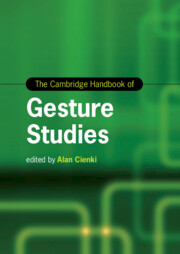Book contents
- The Cambridge Handbook of Gesture Studies
- Cambridge Handbooks in Language and Linguistics
- The Cambridge Handbook of Gesture Studies
- Copyright page
- Contents
- Figures
- Tables
- Contributors
- Introduction
- Part I Gestural Types: Forms and Functions
- 1 Emblems
- 2 Recurrent Gestures: Cultural, Individual, and Linguistic Dimensions of Meaning-Making
- 3 Iconicity, Schematicity, and Representation in Gesture
- 4 Indexicality, Deixis, and Space in Gesture
- 5 From the Neck Up: Facial Gestures in Dialogue
- Part II Ways of Approaching Gesture Analysis
- Part III Gestures and Language
- Part IV Gestures in Relation to Cognition
- Part V Gestures in Relation to Interaction
- Index
- References
4 - Indexicality, Deixis, and Space in Gesture
from Part I - Gestural Types: Forms and Functions
Published online by Cambridge University Press: 01 May 2024
- The Cambridge Handbook of Gesture Studies
- Cambridge Handbooks in Language and Linguistics
- The Cambridge Handbook of Gesture Studies
- Copyright page
- Contents
- Figures
- Tables
- Contributors
- Introduction
- Part I Gestural Types: Forms and Functions
- 1 Emblems
- 2 Recurrent Gestures: Cultural, Individual, and Linguistic Dimensions of Meaning-Making
- 3 Iconicity, Schematicity, and Representation in Gesture
- 4 Indexicality, Deixis, and Space in Gesture
- 5 From the Neck Up: Facial Gestures in Dialogue
- Part II Ways of Approaching Gesture Analysis
- Part III Gestures and Language
- Part IV Gestures in Relation to Cognition
- Part V Gestures in Relation to Interaction
- Index
- References
Summary
This chapter gives an overview of the relation between indexicality, deixis, and space in gesture from a semiotic and a linguistic point of view. Directive pointing gestures are not the only type of cospeech gestures that contributes to deixis. Iconic gestures that form part of the multimodal utterance may instantiate the targets to be pointed at and function as the deictic object of the deictic relation. In turn they may be interpreted as signs that stand for something else. A Peircean approach combined with a Bühlerian one, as suggested in this chapter, not only allows for a tertium comparationis with respect to the modality of the deictic and indexical signs under investigation. It also provides us with tools for representing semiotic processes like complex sign concatenation (e.g. deixis at signs vs. deixis at non-signs; deixis at metonymies or metaphors) as well as the collaborative creation of deictic space (sphere-like, map-like, screen-like; separated or shared) in multimodal interaction. The proposed schema of four semiotic subfields of space substantiates the view that space has to be thought of as a dynamic process of semiosis, not as a static entity.
Keywords
Information
- Type
- Chapter
- Information
- The Cambridge Handbook of Gesture Studies , pp. 84 - 111Publisher: Cambridge University PressPrint publication year: 2024
